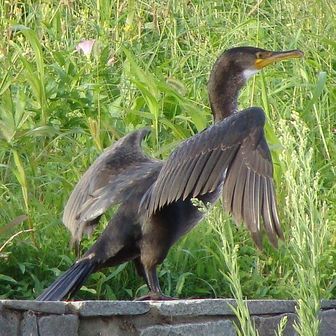Japanese Cormorant
The Japanese Cormorant has a black body with a white throat and cheeks and a partially yellow bill.

Original source: 青森県 西津軽郡 旧:小泊村 (投稿者自身による撮影) Transferred from ja.wikipedia; transferred to Commons by User:Berichard using CommonsHelper.
Author: Aomorikuma(あおもりくま)/http://ja.wikipedia.org/wiki/利用者:あおもりくま_あおもりくま あおもりくま Original uploader was あおもりくま at ja.wikipediaPermission(Reusing this file)CC-BY-3.0; GFDL-NO-DISCLAIMERS.
Permission: GNU Free Documentation License
The Japanese Cormorant is classified as Least Concern. Does not qualify for a more at risk category. Widespread and abundant taxa are included in this category.
The Japanese Cormorant has a black body with a white throat and cheeks and a partially yellow bill. It is one of the species of cormorant that has been domesticated by fishermen in a tradition known in Japan as ukai (鵜飼). It is called umiu (ウミウ sea cormorant) in Japanese. The Nagara River's well-known fishing masters work with this particular species to catch ayu. Footnotes - 1. ^ Cormorant Fishing "UKAI". More
Japanese cormorants are sexually dimorphic: The male is 25 percent heavier than the female, and can dive deeper and for longer than the female. Males can reach depths of 15 meters and remain underwater for almost a minute. Birds of both sexes dive quickly to their maximum depth, hunt for fish during a "bottom phase," and ascend. In ukai fishing, a metal ring is fastened around the base of the cormorant's neck, preventing it from swallowing any fish. More
capillatus: The Japanese Cormorant is native to East Asia, from Taiwan north through Korea and Japan to the Russian Far East. The Japanese Cormorant has a black body, with a white throat and cheek, and a partially yellow bill. More
experience UKAI, or Japanese cormorant fishing, which would begin at 7:30 p.m in a nearby river. We spent the next hour or so touring the nearby shops - actually, I spent the hour sending off text messages while trying to kill time - allowing my mother to do some "much-needed" shopping. We bought tickets just after 7:00 p.m., and spent the next 30 minutes chatting while the Japanese fisherman prepared the boats and cormorants. More
Aspects of the topic Japanese cormorant are discussed in the following places at Britannica. Assorted References * characteristics (in cormorant (bird)) ...it breeds from eastern Canada to Iceland, across Eurasia to Australia and New Zealand, and in parts of Africa. It and the slightly smaller Japanese cormorant, P. capillatus, are the species trained for fishing. More

Original source: Michael Jefferies
-Michael Jefferies -Author: Michael Jefferies
Permission: Some rights reserved
Family : Phalacrocoracidae
Genus : Phalacrocorax
Species : capillatus
Authority : (Temminck & Schlegel, 1850)
